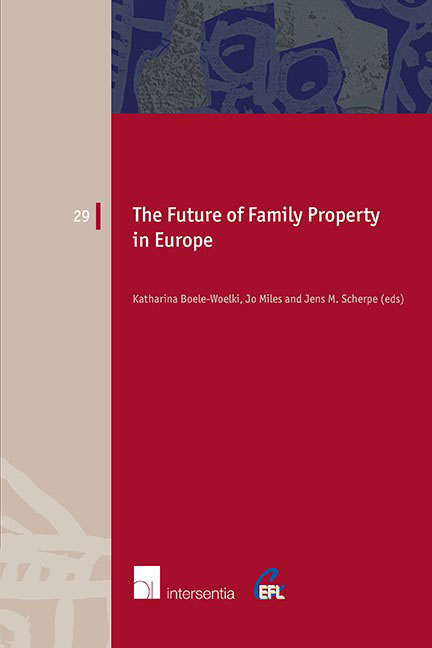Book contents
- Frontmatter
- Preface
- Contents
- List of authors
- PART ONE KEYNOTE LECTURE
- PART TWO MATRIMONIAL PROPERTY LAW IN EU ROPE
- PART THREE FAMILY CONTRACTS – ISSUES OF AUTONOMY
- PART FOUR PROTECTION OF OLDER PEOPLE IN LAW
- PART FIVE FREEDOM OF TESTATION AND PROTECTION OF FAMILY MEMBERS
- PART SIX CHILD MAINTENANCE
- PART SEVEN UNIFICATION OF PRIVATE INTERNATIONAL FAMILY LAW
- PART EIGHT CLOSING REMARKS
Balancing Interests – How Much Freedom of Testation?
Published online by Cambridge University Press: 08 May 2020
- Frontmatter
- Preface
- Contents
- List of authors
- PART ONE KEYNOTE LECTURE
- PART TWO MATRIMONIAL PROPERTY LAW IN EU ROPE
- PART THREE FAMILY CONTRACTS – ISSUES OF AUTONOMY
- PART FOUR PROTECTION OF OLDER PEOPLE IN LAW
- PART FIVE FREEDOM OF TESTATION AND PROTECTION OF FAMILY MEMBERS
- PART SIX CHILD MAINTENANCE
- PART SEVEN UNIFICATION OF PRIVATE INTERNATIONAL FAMILY LAW
- PART EIGHT CLOSING REMARKS
Summary
INTRODUCTION
In my view, the main purpose of succession law legislation is to strike a reasonable balance between the interests of (1) the surviving spouse (or cohabitant), (2) the interests of other family members and (3) the deceased's own preferences for the distribution of his property. The question of how to perform this balancing act has been answered in widely diverse ways throughout history and in different jurisdictions. The purpose of this paper is to identify different ways of balancing these, often conflicting, interests. Within the rules of inheritance law, there are several concepts of legal protection of the surviving spouse or other surviving relatives. I will focus on four main concepts of legal protection within the law of succession and show how – and to what extent – these concepts are applied in Norwegian law.
There are of course alternatives that do not imply any balancing of interests. One unbalanced solution is to provide the lineal descendants with a legitimate portion or indefeasible share of the entire estate. Another solution, unbalanced in favour of the surviving spouse, is to provide her with a legitimate portion which amounts to the entire estate. A third alternative is to provide the deceased with unlimited freedom of testation. My focus is to identify different ways of balancing the interests. Therefore, I will not pay much attention to unbalanced solutions.
When discussing inheritance rights, especially the inheritance rights of the surviving spouse, one should bear in mind that community property is the default family property regime in many civil law jurisdictions. Thus inheritance and legitimate portion is a question of how much the widow or widower is entitled to of the deceased's assets in addition to his or her share of the community property. Upon one spouse's death, community property is usually split into halves. One half constitutes the survivor's share in the community property and thus belongs to him, whereas the estate of the predeceasing spouse consists of the other half of the community property, along with such assets as the predeceasing spouse may have owned in his own right (as separate assets). To some extent the surviving spouse receives double protection.
- Type
- Chapter
- Information
- The Future of Family Property in Europe , pp. 229 - 250Publisher: IntersentiaPrint publication year: 2011

